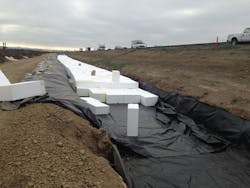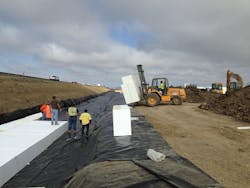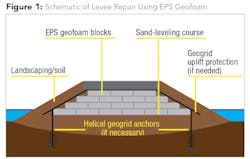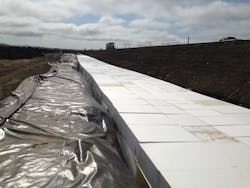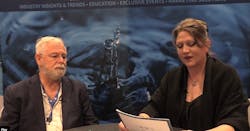Expanded Polystyrene Geofoam Vital to Wetlands Restoration Project
By Sean O’Keefe
Public infrastructure contractors know that every project is unique regardless of how many times similar challenges have been faced before. When it comes to heavy civil construction involving the ever-so-delicate restoration of a natural wetlands area, those differences can be magnified significantly by specific soil conditions. When Maggiora & Ghilotti, Inc. of San Rafael, Calif., was hired to work on a wetlands levee reinforcement project 40 miles inland from San Francisco, Vice President Scott Ghilotti knew he’d be looking for innovative solutions.
“Restoring a wetlands area requires a combination of construction know-how and an appreciation for the long-term impacts on the natural environment,” noted Ghilotti. “The loose nature of the sediment and the dampness of the dirt really affect our ability to get heavy equipment in and out of the site. We invest a lot of time in understanding the soil conditions and often have to go beyond typical construction methodologies to resolve challenges presented by the soil.”
As a fourth-generation builder in a family-owned business, Ghilotti is well aware that solving problems often translates to unconventional uses of common construction materials. Known as Cullinan Ranch, the project is part of a broader effort to restore some 1,500 acres of tidal wetlands in the San Pablo Bay National Wildlife Refuge. Wetlands projects often involve a combination of state and federal agencies, third party conservationists, as well as the engineers and contractors commissioned to do the work. In the case of Cullinan Ranch, those entities included the U.S. Fish and Wildlife Service (FWS), CalTrans (the state highway department) and Ducks Unlimited, the world’s leader in wetlands and waterfowl conservation.
For Maggiora & Ghilotti, the primary scope of work was the reinforcement of a roadway levee supporting State Route 37, which serves as a vital connection between four counties in the North Bay Area. Before restoration efforts were initiated, the site had been diked off from natural times and used as oat and hay farmlands for more than 100 years. Recreating a wetlands area that would be natural and appealing to fowl and other wildlife required the reinforced roadway embankment to mimic a transitional zone between the roadway and the wetlands area in a long, gentle slope rather than a steep grade. Creating the desired slope therefore meant adding a substantial amount of material between the elevated roadway levee and the restored wetlands area below.
For project stakeholder CalTrans, this posed several key challenges that had to be resolved to avoid long-term complications. Because of the area’s very soft soils, known locally as “Bay Mud,” state engineers were concerned that adding a large volume of weight to the embankment (in the form of additional soil or even a lightweight concrete fill) could contribute to roadway settlement over time, potentially damaging the levee’s stability. The other concern was that a slope fill solution involving soil exclusively would likely suffer the effects of erosion over time as water washing from the roadway down the side of the hill would eventually require new soil to be added to maintain the desired transitional zone at the bottom of the slope.
Ducks Unlimited suggested using expanded polystyrene (EPS) Geofoam as a solution to the structural-fill challenge because it is lightweight and has an extremely high compressive strength (see Fig. 1). At about one percent of the weight of soil, ACH Foam Technologies’ Geofoam is a cellular plastic material with a compressive resistance up to 18.6 psi at one percent deformation, making it an ideal solution to a complex problem.
Once the construction documents were completed, Ducks Unlimited advertised the project as a hard-bid solicitation. Maggiora & Ghilotti Inc. was selected for a combination of previous project successes with Ducks Unlimited and low-bid price. With the contract in place, Scott Ghilotti and the Maggiora & Ghilotti team went to work purchasing the required construction materials including the EPS foam blocks that had been specified as the fill solution.
“We hadn’t ever used EPS Geofoam before, but the guys at ACH Foam Technologies were really very helpful,” said Ghilotti. “They were very detailed in their explanation of the manufacturing process, including performance specifications, available block sizes, and how they were willing to pre-cut the blocks to individual dimensions as long as the cuts were straight lines.”
With the specific block dimensions determined, Ghilotti then mapped out a configuration pattern for each section of fill in order to create the slope’s required grades for the two-mile length of the reinforced embankment. Because of the hard-bid solicitation, minimizing the amount of wasted material was a critical component of Ghilotti’s cost model. With a carefully calculated foam block configuration pattern for each section of fill, Ghilotti was able to maximize material use and, in the end, product waste was less than a quarter of a percent across the entire scope of the project.
During construction the first step was to scrape and compact the existing drainage ditch at the bottom of the embankment. Then the ditch was lined with a gas-resistant membrane to protect the foam from potentially corrosive contaminants washing down from the roadway above. The cut-to-size foam was brought to the site on trucks in a just-in-time delivery strategy that allowed Maggiora & Ghilotti’s crews to unload each section of blocks in the exact order they were needed. Laborers were able to quickly place the blocks according to Ghilotti’s configuration pattern in something of an assembly line process with limited need for material staging or protective storage. More than 15,000 cubic yards of EPS 29 Geofoam were used and Ghilotti estimates that the team installed an average of 1,500 yards of block each day without complications.
As the sections of foam were put in place, the overlapping edges of the gas-resistant membrane were wrapped across the top and fused together to seal the blocks inside. With the structural fill in place, it was the last step in creating the embankment that caused Ghilotti the most concern.
“The over-fill, compaction, and grading processes happening on top of the wrapped foam blocks seemed like it would be a very delicate operation,” noted Ghilotti. “Moving the amount of dirt required for this project was going to mean using machines that weigh around 35+ tons fully loaded with dirt. It just didn’t seem possible that equipment that heavy could move around much on top of an embankment supported by foam blocks without damaging them.” The ACH Foam Technologies team, however, assured him that between 12 and 18 inches of soil placed over the wrapped foam would be enough to support the weight of the heaviest equipment needed - and they were right.
Ghilotti was quick with an answer when asked what other contractors might find most compelling about ACH Foam Technologies’ Geofoam: “All you can really expect of a construction material is that it performs as planned. In the case of the Geofoam blocks, they filled the gap without adding a lot of weight to the embankment and were able to support the weight of the incredibly heavy equipment the same as soil would. The product was also extremely easy to work with and the people at ACH were very helpful in setting up an efficient installation that went off without a hitch.”
The high turn-up ratios in sewer flow are a result of both aging infrastructure and climate change, and they are here to stay. Designers should therefore prepare to employ staged pump systems (i.e., a combination of SCADA-driven low-flow to high-flow pumps) to accommodate the wide range of flows efficiently. Using a high number (3 or 4) of identical pumps often results in diminishing returns of flow for every additional pump engaged due to steep system curves for an economical force main, such that more pumps are less effective in handling peak storm-driven flows. This is a key aspect of resiliency and adaptability of the pumped sewage system.
Flow should be consolidated where possible. Smaller lift stations struggle to perform when discharging to systems with large, continuously operating lift stations. Gravity flow or station-to-station pumping should be used where possible to discharge to larger wet wells and pumps that handle the total flow. Connecting directly to large common discharge headers may present pump selection issues and operational constraints, although pressure vessels can lessen the impact of uncoordinated or unplanned pump starts or stops (or power failures).
Hydraulic modeling is an invaluable tool in minimizing long-term costs and it should be employed in the earliest possible stages of design. Minor system features can be identified by hydraulic modeling that can make large budgetary differences - a pressure sustaining valve or right-sized air valve, for example. For large or complex projects, consider both 3D flows in sumps and hydraulic transients for operations.
Retrofitting and modifying wastewater systems is a daunting and costly task. The design of new systems and lift stations should employ long-term resiliency thinking.
About the Author: Sean O’Keefe has more than 15 years of experience writing about the design and construction industry. He provides integrated communications services to architects, engineers, and contractors ranging from public relations to marketing strategy. He can be reached at [email protected].
More WaterWorld Current Issue Articles
More WaterWorld Archives Issue Articles
